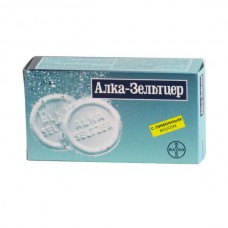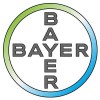Expiration date: 06/2026
The composition and form of issue:
Effervescent tablets, 1 tablet contains:
acetylsalicylic acid 324 mg
citric acid anhydrous 965 mg
sodium carbonate 1625 mg odnosemjannyj
auxiliary substances: povidone 25 siloxane/silicate doss sodium benzoate sodium saccharin flavours — lemon and lime
the strip 2 PCs., in a cardboard pack 5 strips or strip 10 PCs., the paper cartons 1 or 2 strip.
Description pharmaceutical form:
Round flat white pills, one side engraved "ALKA SELTZER", in acting on the perimeter of the convex circle into the other facet.
Description pharmacological action:
Combined drug action is due to its constituent components.
Acetylsalicylic acid has analgesic, antipyretic, anti-inflammatory effect due to inhibition of the COX enzymes involved in the synthesis of PG. Acetylsalicylic acid inhibits platelet aggregation by blocking synthesis of thromboxane A2.
Sodium carbonate neutralizes free hydrochloric acid in the stomach, which reduces the irritant effect of the drug.
Citric acid promotes more rapid absorption of the drug.
Indications:
symptomatic treatment of pain syndrome headache (including excessive alcohol consumption), toothache, sore throat, back pain and muscle pain joint pain during menstruation
fever with colds and other infectious and inflammatory diseases (in adults and children older than 15 years).
Contraindications:
- hypersensitivity to acetylsalicylic acid and other NSAIDs or other components of the drug
- erosivno-azwenne shock syndrome (in the acute phase)
- hemorrhagic diathesis
- combined use of methotrexate in a dose of 15 mg per week or more
- asthma caused by ingestion of salicylates or other NSAIDs
- pregnancy (I and III trimester)
- breastfeeding
- children under 15 years with acute respiratory disease, caused by viral infections, because of the risk of Reye's syndrome (encephalopathy and acute fatty degeneration of the liver with acute hepatic insufficiency).
With caution:
- concomitant therapy with anticoagulants
- gout
- peptic ulcer and/or duodenal ulcers (in history), including chronic or relapsing course of peptic ulcer disease, or episodes of gastrointestinal bleeding
- renal and/or hepatic insufficiency
- the deficit glukozo-6-fosfatdegidrogenaza.
Application of pregnancy and breast-feeding:
Contraindicated in I and III trimester of pregnancy.
If necessary, use of the drug during lactation breastfeeding should be discontinued.
Side effects:
Sometimes it is possible to:
Gastrointestinal: abdominal pain, heartburn, nausea, vomiting, clear (vomiting blood, tarry stools) or hidden signs of gastrointestinal bleeding, which can lead to iron deficiency anemia, erosive-ulcerative lesions (including perforation) of the gastrointestinal tract, individual cases of violations of the liver (increased liver transaminases).
With the hematopoietic system: increased risk of bleeding that is the result of the influence of acetylsalicylic acid on platelet aggregation.
Allergic reactions: skin rash, anaphylactic reaction, bronchospasm, angioedema.
If you notice such symptoms should stop taking the drug and immediately consult your doctor.
Drug interactions:
Joint application:
- with methotrexate dose 15 mg per week or more: increased hemolytic cytotoxicity of methotrexate (decreased renal clearance of methotrexate and methotrexate is substituted salicylates in the blood plasma)
- anticoagulants, e.g. heparin: increased risk of bleeding by inhibiting platelet function, damage of the gastrointestinal mucosa, displacement of the anticoagulants (oral) from the blood plasma
- with other NSAIDs, and large doses of salicylates (3 g per day or more): as a result of the synergistic interaction increased risk of ulcers and bleeding
- uricosurica, such as benzbromarone: reduces uricosuric effect
- digoxin: increased digoxin concentration due to reduction of renal excretion
- with antidiabetic drugs, e.g. insulin: increased hypoglycemic effect of antidiabetic drugs due to the hypoglycemic action of acetylsalicylic acid
- with drugs of the group of thrombolytics: risk of bleeding increases
- with diuretics at a dose of 3 mg per day or more: reduced glomerular filtration due to decreased synthesis of PG
- with systemic corticosteroids, except hydrocortisone used as replacement therapy in Addison's disease: the use of GCS reduced the level of salicylates in the blood by increasing the excretion last
- with ACE inhibitors: a dose of 3 g per day or more reduced glomerular filtration due to the inhibition of PG and, as a consequence of reduced antihypertensive effect
- valproic acid: increased toxicity of valproic acid
- ethanol increases the risk of the damaging effects on the mucosa of the gastrointestinal tract and increases bleeding time.
Method of application and dose:
Inside, tentatively rastvoriv in a glass of water.
Adults and children over 15 years — 1 table. up to 6 times per day. In severe pain and high temperature — 2-3 table. the maximum daily dose should not exceed 9 table. (3 g).
The interval between meals preparation shall be not less than 4 h. the Regular adherence of the drug allows to avoid a sharp rise in temperature and reduce the intensity of pain.
The duration of treatment (without consulting a doctor) should not exceed 5 days at appointment as an anesthetic and for more than 3 days as antipyretic.
Overdose:
Symptoms: overdose of moderate severity, nausea, vomiting, tinnitus, hearing loss, headache, dizziness and confusion. These symptoms are at lower dosages.
Severe overdosage: fever, hyperventilation, ketosis, respiratory alkalosis, metabolic acidosis, coma, cardiogenic shock, respiratory failure, severe hypoglycemia.
Treatment: symptomatic therapy, hospitalization, lavage, administration of activated charcoal, monitoring of acid-base balance, alkaline diuresis, in order to obtain urine pH between 7, 5-8 (forced alkaline diuresis is considered to be achieved if the concentration of salicylate in plasma is more than 500 mg/l — (3, 6 mmol/l in adults or 300 mg/l — 2, 2 mmol/l in children), hemodialysis, recovery of fluid loss.
Special instructions:
Acetylsalicylic acid can cause bronchospasm, bronchial asthma attacks or other hypersensitivity reactions.
Risk factors are the presence of asthma, nasal polyps, fever, chronic bronchopulmonary diseases, cases of Allergy history (allergic rhinitis, skin rash).
Acetylsalicylic acid may increase the tendency to bleed due to an inhibitory effect on platelet aggregation. This should be considered if necessary, surgical interventions, including small interventions, such as tooth extraction. Before surgery to minimize bleeding during the operation and postoperative period should stop taking the drug for 5-7 days and notify the physician.
If necessary, use of the drug during lactation breastfeeding should be discontinued.
The kids aren't allowed to prescribe drugs containing acetylsalicylic acid, as in the case of a viral infection increases the risk of Reye's syndrome. Symptoms of Reye's syndrome are prolonged vomiting, acute encephalopathy, enlarged liver.
In the treatment of vascular diseases, the daily dose of acetylsalicylic acid is from 75 to 300 mg.
Acetylsalicylic acid reduces the excretion of uric acid from the body, which can cause an acute attack of gout in predisposed patients.
In one effervescent tablet drug Alka-Seltzer contains 445 mg of sodium, which should be considered when a diet with controlled sodium intake.
Not identified impact of the drug on motor vehicles and other mechanisms.


